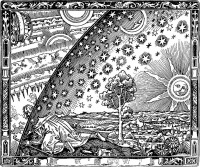Camille Flammarion
From The Art and Popular Culture Encyclopedia

Flammarion engraving, a wood engraving by an unknown artist, so named because its first documented appearance is in Camille Flammarion's 1888 book L'atmosphère: météorologie populaire ("The Atmosphere: Popular Meteorology").
|
Related e |
|
Featured: |
Nicolas Camille Flammarion (26 February 1842—3 June 1925) was a French astronomer and author. He was a prolific author of more than fifty titles, including popular science works about astronomy, several notable early science fiction novels, and several works about Spiritualism and related topics. He also published the magazine L'Astronomie, starting in 1882. He maintained a private observatory at Juvisy-sur-Orge, France.
[edit]
Works
- La pluralité des mondes habités (The Plurality of Inhabited Worlds), 1862.
- Real and Imaginary Worlds, 1865.
- God in nature, 1866. Flammarion argues that the mind is independent of the brain.
- Récits de l'infini, 1872 (translated into English as Stories of Infinity in 1873).
- Lumen (available online)
- History of a Comet
- In Infinity
- Distances of the Stars, 1874. Popular Science Monthly V.5, Aug 1874. Translated in English from La Nature. (available online)
- L'atmosphère: météorologie populaire, 1888.
- Astronomie populaire, 1880. His best-selling work, it was translated into English as Popular Astronomy in 1894.
- Les Étoiles et les Curiosités du Ciel, 1882. A supplement of the L'Astronomie Populaire works. An observer's handbook of its day.
- Uranie (available online), 1889 (translated into English as Urania in 1890).
- La planète Mars et ses conditions d'habitabilité, 1892.
- La Fin du Monde (The End of the World), 1893 (translated into English as Omega: The Last Days of the World in 1894), is a science fiction novel about a comet colliding with the Earth, followed by several million years leading up to the gradual death of the planet, and has recently been brought back into print. It was adapted into a film in 1931 by Abel Gance.
- Stella (1897)
- L’inconnu et les problèmes psychiques (published in English as: L’inconnu: The Unknown), 1900, a collection of psychic experiences.
- Mysterious psychic forces: an account of the author's investigations in psychical research, together with those of other European savants , 1907
- Death and its mystery—proofs of the existence of the soul; Volume 1—Before death, 1921
- Death and its mystery—proofs of the existence of the soul; Volume 2—At the moment of death, 1922
- Death and its mystery—proofs of the existence of the soul; Volume 3—After death, 1923
- Haunted houses, 1924
Unless indicated otherwise, the text in this article is either based on Wikipedia article "Camille Flammarion" or another language Wikipedia page thereof used under the terms of the GNU Free Documentation License; or on research by Jahsonic and friends. See Art and Popular Culture's copyright notice.

